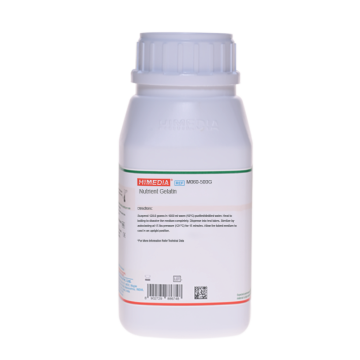 Your enquiry has been submitted
Your enquiry has been submitted
Nutrient Gelatin
Nutrient Gelatin is recommended for detection of gelatin liquefaction by proteolytic microorganisms.
Composition
Ingredients
| Ingredients | Gms / Litre |
|---|---|
| Peptic digest of animal tissue | 5.000 |
| Meat extract | 3.000 |
| Gelatin | 120.000 |
| Sodium chloride | 30.000 |
Final pH (at 25°C): 7.0±0.2
**Formula adjusted, standardized to suit performance parameters
Directions
Suspend 158 grams in 1000 ml of warm (50°C) water. Heat to 50°C to dissolve the medium completely. Dispense into test tubes. Sterilize by autoclaving at 15 lbs pressure (121°C) for 12 minutes.
Principle And Interpretation
Nutrient Gelatin is prepared as per the formulation recommended by BIS (1). Gelatin liquefaction is one of the essential test for the differentiation of enteric bacilli (2). This medium can also be used for the microbial plate counts of water.
Peptic digest of animal tissue and meat extract supply nutrients for the growth of nonfastidious organisms. Organisms produce gelatinase, a proteolytic enzyme active in the liquefaction of gelatin.
To test gelatin liquefaction the strains are stab inoculated in Nutrient Gelatin. Many species require prolonged incubation (3, 4) for gelatin liquefaction. Gelatin is solid at 20°C or less temperature and liquid at 35°C or higher temperature. Gelatin liquefies at about 28°C, so incubation is carried out at 35°C but kept in a refrigerator for about 2 hours before interpretation of the results (3). Liquefaction of gelatin occurs on the surface layer, so care should be taken not to shake the tubes (5). Control is run along with every testing as gelling ability of gelatin varies (3) and also the gelatin concentration should not exceed 12% as it may inhibit growth (6). For plate counts of water, the incubation is carried out at 20-22°C upto 30 days.
Quality Control
Appearance Cream to yellow coloured homogeneous free flowing slightly coarse powder
Gelling Semisolid, comparable with 12% Gelatin gel.
Colour and Clarity of prepared medium Light amber coloured clear to slightly opalescent gel forms in tubes
Reaction Reaction of 15.8% w/v aqueous solution at 25°C. pH : 7.0±0.2
pH 6.80-7.20
Cultural Response
M060S: Cultural characteristics after 1 to 7 days at 35 - 37°C.
Cultural Response
| Organism | Inoculum (CFU) | Growth | Gelatinase |
|---|---|---|---|
| Clostridium perfringens ATCC 12924 | 50-100 | good-luxuriant | Positive reaction |
| Bacillus cereus ATCC 10876 | 50-100 | good-luxuriant | Positive reaction |
| Bacillus subtilis ATCC 6633 | 50-100 | good-luxuriant | Positive reaction |
| Escherichia coli ATCC 25922 | 50-100 | good-luxuriant | Negative reaction |
| Proteus vulgaris ATCC 13315 | 50-100 | good-luxuriant | Positive reaction |
| Staphylococcus aureus ATCC 25923 | 50-100 | good-luxuriant | Positive reaction |
Storage and Shelf Life
Store below 30°C in tightly closed container and the prepared medium at 2 - 8°C. Use before expiry date on the label.
Reference
- Bureau of Indian Standards IS: 5887 (Part IV) 1976.
- Ewing, 1986, Edwards and Ewings Identification of Enterobacteriaceae, 4th ed., Elsevier Science Publishing Co., Inc. New York.
- Cawan S. and Steel K., 1966, Manual for the Identification of Medical Bacteria, Cambridge University Press, Pg. 19, 27-28, 116 and 156.
- Lautrop H., 1956, Acta Pathol. Microbiol. Scand., 39:357.
- Frobisher M., 1957, Fundamentals of Microbiology, 6th ed., W.B. Saunders Co., Philadelphia, P:239.
- Branson D., 1972, Methods in Clinical Bacteriology, Springfield, Ill, pg 21.
| Product Name | Nutrient Gelatin |
|---|---|
| SKU | M060S |
| Product Type | Regular |
| Physical Form | Powder |
| Origin | Animal |
| Packaging type | HDPE |
| References | 1. American Public Health Association, 1975, Standard Methods for the Examination of Water and Wastewater, 14th Ed.,APHA, Washington, D.C. 2.Ewing, 1986, Edwards and Ewings Identification of Enterobacteriaceae, 4th Ed., Elsevier Science Publishing Co., Inc. NewYork. 3.Cawan S. and Steel K., 1966, Manual for the Identification of Medical Bacteria, Cambridge University Press, Pg. 19, 27-28,116 and 156. 4.Lautrop H., 1956, Acta. Pathol. Microbiol. Scand., 39:357. 5.Frobisher M., 1957, Fundamentals of Microbiology, 6th Ed., W.B. Saunders Co., Philadelphia, p. 239. 6.Branson D., 1972, Methods in Clinical Bacteriology, Springfield, III, pg. 21. |
| Customized Product Available | No |





